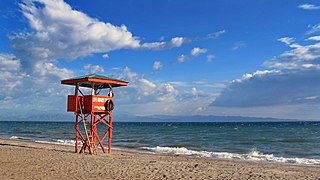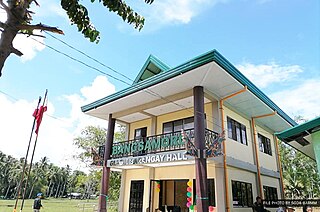
In the Philippines, regions are administrative divisions that primarily serve to coordinate planning and organize national government services across multiple local government units (LGUs). Most national government offices provide services through their regional branches instead of having direct provincial or city offices. Regional offices are usually but not necessarily located in the city designated as the regional center.

Maguindanao was a province of the Philippines located in the Bangsamoro Autonomous Region in Muslim Mindanao (BARMM). From 2014 to 2022, its provincial capital was Buluan, but the legislative branch of government, the Maguindanao Provincial Board, convened at the old provincial capitol in Sultan Kudarat. It bordered Lanao del Sur to the north, Cotabato to the east, Sultan Kudarat to the south, and Illana Bay to the west.

Cotabato or North Cotabato, officially the Province of Cotabato, is a landlocked province in the Philippines located in the Soccsksargen region in Mindanao. Its capital is the city of Kidapawan. Some of its barangays are under the jurisdiction of the nearby Bangsamoro Autonomous Region.

Soccsksargen, formerly known as Central Mindanao, is an administrative region of the Philippines, designated as Region XII. Located in south-central Mindanao, its name is an acronym that stands for the region's four provinces and one highly urbanized city. The regional center is in Koronadal, located in the province of South Cotabato, and the center of commerce and industry is General Santos, which is the most populous city in the region.

The Autonomous Region in Muslim Mindanao was an autonomous region of the Philippines, located in the Mindanao island group of the Philippines, that consisted of five predominantly Muslim provinces: Basilan, Lanao del Sur, Maguindanao, Sulu, and Tawi-Tawi. It was the only region that had its own government. The region's de facto seat of government was Cotabato City, although this self-governing city was outside its jurisdiction.
Elections in the Philippines are of several types. The president, vice-president, and the senators are elected for a six-year term, while the members of the House of Representatives, governors, vice-governors, members of the Sangguniang Panlalawigan, mayors, vice-mayors, members of the Sangguniang Panlungsod/members of the Sangguniang Bayan, barangay officials, and the members of the Sangguniang Kabataan are elected to serve for a three-year term.

Buluan, officially the Municipality of Buluan, is a 4th class municipality and capital of the province of Maguindanao del Sur, Philippines. According to the 2020 census, it has a population of 57,406 people.

Sumisip, officially the Municipality of Sumisip, is a 1st class municipality in the province of Basilan, Philippines. According to the 2020 census, it has a population of 47,345 people.

Shariff Aguak, officially the Municipality of Shariff Aguak, is a 3rd class municipality in the province of Maguindanao del Sur, Philippines. According to the 2020 census, it has a population of 33,982 people.

Parang, officially the Municipality of Parang, is a 1st class municipality in the province of Maguindanao del Norte, Philippines. According to the 2020 census, it has a population of 102,914 people.

Talitay, officially the Municipality of Talitay, is a municipality in the province of Maguindanao del Norte, Philippines. According to the 2020 census, it has a population of 17,463 people.

Datu Montawal, officially the Municipality of Datu Montawal, is a 5th class municipality in the province of Maguindanao del Sur, Philippines. According to the 2020 census, it has a population of 37,314 people.
The Philippines is divided into four levels of administrative divisions, with the lower three being defined in the Local Government Code of 1991 as local government units (LGUs). They are, from the highest to the lowest:
- Regions are mostly used to organize national services. Of the 17 regions, only one—the Bangsamoro Autonomous Region in Muslim Mindanao—has an elected government to which the central government has devolved competencies.
- Provinces, independent cities, and one independent municipality (Pateros)
- Component cities and municipalities within a province
- Barangays within a city or municipality

Shariff Kabunsuan was a short-lived province of the Philippines within the Autonomous Region in Muslim Mindanao (ARMM) that existed from 2006 to 2008. Its designated seat of government was Datu Odin Sinsuat. Initially comprising ten municipalities carved out of Maguindanao, Shariff Kabunsuan was created by virtue of Muslim Mindanao Autonomy Act No. 201; this law was nullified by the Supreme Court of the Philippines in 2008, thus disestablishing the province.

Datu Blah T. Sinsuat, officially the Municipality of Datu Blah T. Sinsuat, is a municipality in the province of Maguindanao del Norte, Philippines. According to the 2020 census, it has a population of 28,243 people.

Bangsamoro, officially the Bangsamoro Autonomous Region in Muslim Mindanao is an autonomous region in the Philippines, located in the southwestern portion of the island of Mindanao.

An autonomous region of the Philippines is a first-level administrative division that has the authority to control a region's culture and economy. The Constitution of the Philippines allows for two autonomous regions: in the Cordilleras and in Muslim Mindanao. Currently, Bangsamoro, which largely consists of the Muslim-majority areas of Mindanao, is the only autonomous region in the country.

The 2019 Bangsamoro autonomy plebiscite was a two-part plebiscite held in Mindanao, Philippines, that ratified the Bangsamoro Organic Law (BOL) and replaced the Autonomous Region in Muslim Mindanao (ARMM) with the Bangsamoro Autonomous Region in Muslim Mindanao (BARMM), as well as the scope of the said region.

The Special Geographic Area (SGA) is a loose collection of 63 barangays in six municipalities of the province of Cotabato in the Philippines. It is part of the Bangsamoro Autonomous Region in Muslim Mindanao, despite the province of Cotabato itself being part of a separate neighboring region, Soccsksargen.

The transition period of the now-defunct Autonomous Region in Muslim Mindanao (ARMM) into the Bangsamoro Autonomous Region in Muslim Mindanao (BARMM) began when the Bangsamoro Organic Law was ratified in a two-part plebiscite held in January and February 2019. It is set to end after the first set of regular officials are elected in 2025.


















